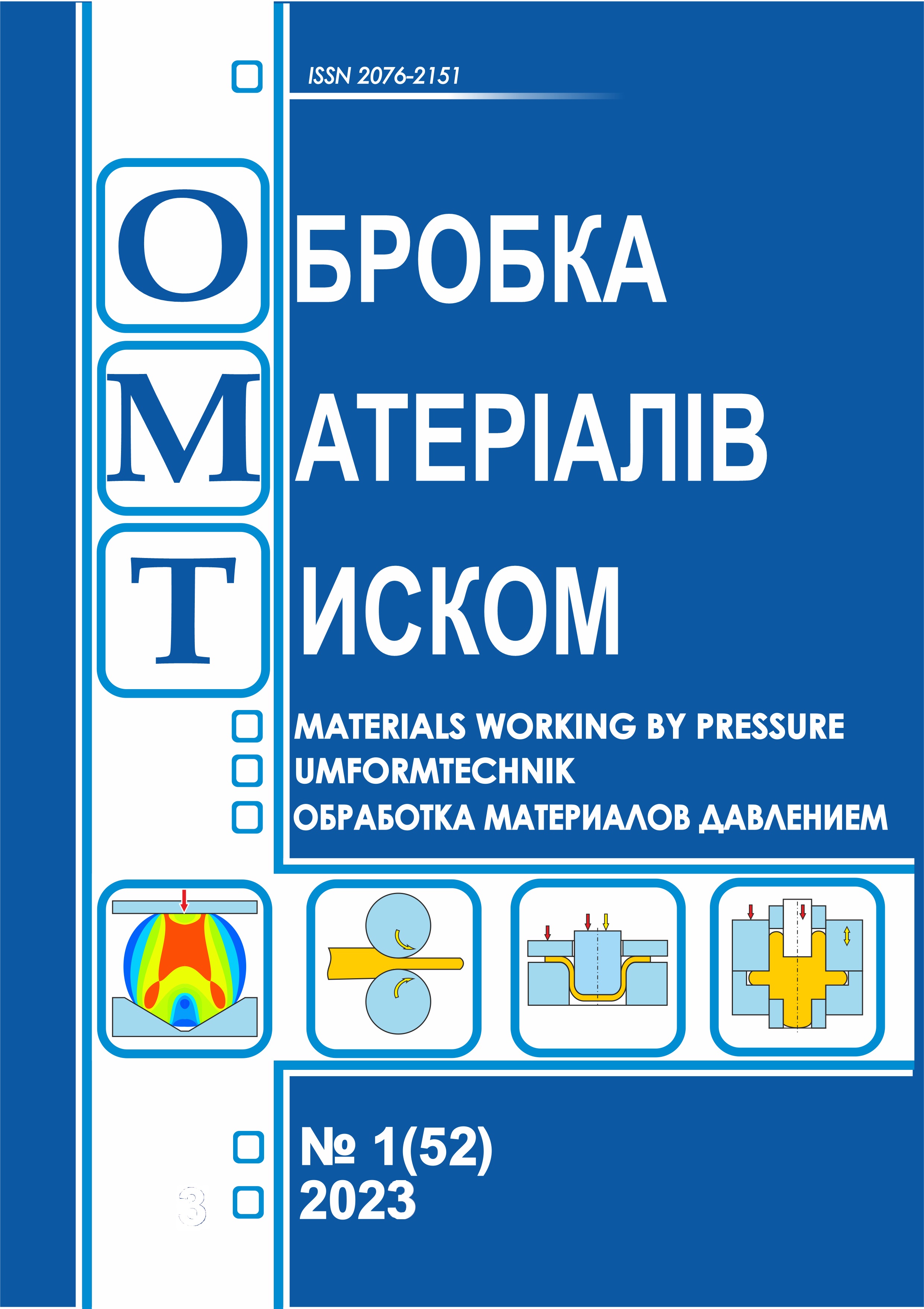Prediction of the stress-strain state of the workpiece for a new method of severe plastic deformation using a CAE-system and a neural network
DOI:
https://doi.org/10.37142/2076-2151/2023-1(52)55Keywords:
severe plastic deformation, CAE, Abaqus, finite element method, artificial neural network, convolutional neural network, time series, prediction.Abstract
Tarasov O., Vasylieva, L., Gribkov E., Myroshnychenko D. Prediction of the stress-strain state of the workpiece for a new method of severe plastic deformation using a CAE-system and a neural network.
The scheme of the proposed deformation process makes it possible to intensify shear deformations in the cross section of the workpiece. According to the nature of the impact on the workpiece, it corresponds to the methods of severe plastic deformation. Unlike other methods of reverse shear, as a result of each deformation operation, a symmetrical cross-sectional shape of the workpiece is obtained. A software complex has been developed for predicting changes in the values of the stress-strain state at given points of the workpiece on the basis of a neural network, which is based on the results of modeling in the SAE system and works in parallel with it. Prediction of the process of changing the stress-strain state of the workpiece during the calculation process in the CAE system is performed using a neural network. The check was performed on the values of the equivalent strain, which was calculated when the number of calculation points in the body of the workpiece was changed from 1 to 5. The time of data preparation, analysis and prediction of values by the neural network did not exceed 60 seconds. The accuracy of the prediction of the values of the equivalent strain, which was obtained as a result of the calculations, varied between 85% and 99%. The dependence of the prediction accuracy on the size of the training data set was also confirmed. This allows you to use a neural network to predict, for example, undesirable trends in the stress-strain state of the workpiece during the calculation process and to stop the CAE-system in time to switch to other values of the calculation parameters. Thus, the combined use of the CAE-system and the neural network can significantly reduce the time for choosing the optimal values of the parameters of the stamp geometry due to the prediction of the stress-strain state at the specified points of the workpiece.
References
Edalati K., Bachmaier A., Beloshenko V. A., Beygelzimer Y., at all. Nanomaterials by severe plastic deformation: Review of historical developments and recent advances. Materials Research Letters. 2022. 10(4), рр. 163-256. https://doi.org/10.1080/21663831.2022.2029779
Tarasov A.F., Altukhov A.V, Gribkov E.P., Abdulov A.R. Development and FEM modeling of a new severe plastic deformation process according to the reverse shear scheme. Modelling and Simulation in Engineering. vol. 2019. Article ID 8563830. 10 pages. 2019. https://doi.org/10.1155/2019/8563830
Frodal. B.H., Christiansen E., Myhr O.R., Hopperstad O.S. The role of quench rate on the plastic flow and fracture of three aluminium alloys with different grain structure and texture. International Journal of Engineering Science. 2020. 150. 103257. https://doi.org/10.1016/j.ijengsci.2020.103257
Dou K., Lordan E., Zhang Y.J., Jacot A.,. Fan Z.Y A complete computer aided engineering (CAE) modelling and optimization of high pressure die casting (HPDC) process. Journal of Manufacturing Processes. 2020. 60, pp. 435–446. https://doi.org/10.1016/j.jmapro.2020.10.062
Zou X., Yan S., Reza Ilkhani M., Brown L., Jones A., Hamadi M. An Abaqus plugin for efficient damage initiation hotspot identification in large-scale composite structures with repeated features, Advances in Engineering Software. 2021. 153. https://doi.org/10.1016/j.advengsoft.2020.102964.
Ning An, Guangyu Yang, Kun Yang, Jian Wang, Meie Li, Jinxiong Zhou, Implementation of Abaqus user subroutines and plugin for thermal analysis of powder-bed electron-beam-melting additive manufacturing process, Materials Today Communications. 2021. 27. https://doi.org/10.1016/j.mtcomm.2021.102307
Youngbin Lim, Sangyul Ha, RufGen: A plug-in for rough surface generation in Abaqus/CAE. SoftwareX. 2023. https://doi.org/10.1016/j.softx.2023.101380
Nesládek M., Španiel M. An Abaqus plugin for fatigue predictions, Advances in Engineering Software, 2017. 103, pp. 1–11. https://doi.org/10.1016/j.advengsoft.2016.10.008
Riano L., Joliff Y., An Abaqus™ plug-in for the geometry generation of Representative Volume Elements with randomly distributed fibers and interphases, Composite Structures. 2019. 209, pp. 644–651. https://doi.org/10.1016/j.compstruct.2018.10.096.
Tarasov O.F., Altukhov O.V., Sagaida P.I., Vasylieva L.V. Automated design and manufacture of products using CAD/CAM/CAE systems: monograph. Kramatorsk: Printing House. 2017. 239 p. ISBN 978-966-379-772-4. (in Ukrainian).
Hu Wang, Yang Zeng, Enying Li, Guangxin Huang, Guoqiang Gao, Guangyao Li. “Seen Is Solution” a CAD/CAE integrated parallel reanalysis design system. Computer Methods in Applied Mechanics and Engineering. 2016. Vol. 299, pp. 187–214. https://doi.org/10.1016/j.cma.2015.10.022.
Peng, L., Liu, L., Long, T. et al. An efficient truss structure optimization framework based on CAD/CAE integration and sequential radial basis function metamodel. Struct Multidisc Optim. 2014. 50, pp. 329–346. https://doi.org/10.1007/s00158-014-1050-x
Liu, D. A Practical Guide to ReLU. 2017. URl: https://medium. com/tinymind/a-practical-guide-to-relu-b83ca804f1f7
Pat. 153484 Ukraina, B22 F3/03. The method of multiple reversible intensive plastic deformation of blanks. Tarasov O.F., Hrybkov E.P., Vasylieva L.V., Altukhov O.V., Pavlenko D.V. 2023. Bul. № 28. (in Ukrainian).

